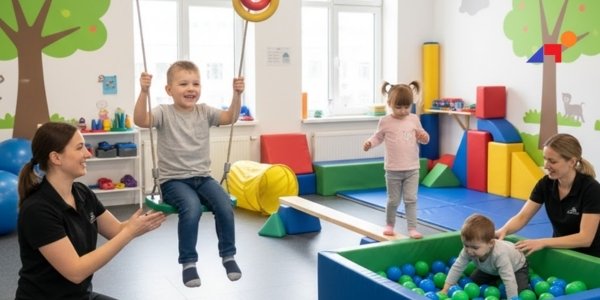Whether your child is starting therapy for the first time, moving between therapeutic settings, or adjusting to changes in routine, the strategies we’ll explore can mean the difference between a smooth adjustment and weeks of regression. By recognizing the early warning signs and implementing proven support strategies, Vancouver parents can help their children not just survive transitions, but actually grow stronger through them.
Understanding Why Transitions Are Particularly Challenging for Children in Therapy
For children receiving pediatric therapy services, transitions represent far more than simple changes in routine—they can trigger complex neurological and emotional responses that impact every aspect of their therapeutic progress. Children in therapy often have heightened sensitivity to environmental changes due to underlying conditions like ADHD, autism, sensory processing differences, or trauma histories that brought them to therapy in the first place.
The neuroscience behind transition difficulties reveals why these challenges are so universal among therapy clients. When children experience changes in their therapeutic environment, their nervous systems often interpret these shifts as potential threats, activating fight-or-flight responses that can persist for weeks. This neurological response isn’t a sign of weakness or regression—it’s a normal protective mechanism that becomes particularly pronounced in children whose neurological systems are already working harder to process daily experiences.
Consider Emma, a 9-year-old Vancouver child with autism who had been working successfully with her occupational therapist at KidStart for eight months. When her therapist took maternity leave, Emma’s parents were prepared for some adjustment challenges, but they weren’t ready for the complete shutdown Emma experienced for three weeks. She stopped speaking in therapy sessions, refused to participate in previously enjoyed activities, and began having meltdowns before each appointment. What Emma’s parents didn’t initially understand was that her response represented a normal neurological response to the loss of a trusted therapeutic relationship.
Attachment dynamics play a crucial role in transition challenges. Children in therapy often develop deep trust bonds with their therapists—relationships that provide the emotional safety necessary for growth and skill development. When these attachments are disrupted, even temporarily, children may unconsciously protect themselves by withdrawing from new therapeutic relationships. This protective response can last anywhere from a few sessions to several months, depending on the child’s attachment style, previous experiences, and the support they receive during the transition.
Vancouver’s current shift toward neurodiversity-affirming therapy practices recognizes that transition challenges often reflect strength rather than deficits. Children who struggle with transitions are often highly sensitive individuals who form deep, meaningful connections and have rich inner emotional lives. Understanding this reframe helps parents approach transition challenges with patience and respect rather than frustration or worry about lost progress.
Early Warning Signs: What Vancouver Parents Should Watch For
Recognizing transition difficulties early allows parents to implement support strategies before challenges escalate into major setbacks. The signs of transition stress often appear days or even weeks before obvious behavioral changes, giving observant parents valuable opportunities to intervene proactively.
Physical and sensory warning signs often emerge first. Children may experience changes in sleep patterns, appetite fluctuations, or increased sensitivity to sounds, textures, or bright lights. A child who previously tolerated busy environments might suddenly become overwhelmed by normal household noise levels. These sensory changes reflect nervous system stress and often precede more obvious behavioral indicators.
Sleep disruptions deserve particular attention, as they both indicate transition stress and compound adjustment difficulties. Children facing therapy transitions might experience difficulty falling asleep, frequent night wakings, or early morning anxiety. Sleep regression often signals that a child’s nervous system is working overtime to process upcoming or recent changes. Parents who notice these sleep changes can implement calming bedtime routines and increase daytime regulation activities to support their child’s adjustment.
Emotional regulation changes provide another valuable early warning system. Children might become more easily frustrated with tasks they previously managed independently, show increased emotional intensity in response to minor disappointments, or demonstrate regression in emotional coping skills they had recently developed. These changes don’t represent lost progress—they indicate temporary overwhelm that typically resolves with appropriate support and time.
Communication patterns often shift during transition periods. Some children become more talkative, asking repeated questions about upcoming changes or expressing worries about new situations. Others become quieter, withdrawing from family conversations or avoiding discussions about therapy. Both responses represent normal attempts to process impending changes. Children who typically express themselves verbally might become more physical in their communication, while children who usually process internally might suddenly become very vocal about their concerns.
Academic or developmental skill changes can also signal transition stress. A child might temporarily struggle with previously mastered tasks like handwriting, tying shoes, or following multi-step directions. These apparent regressions typically reflect temporary cognitive overload rather than actual skill loss. When children’s emotional resources are directed toward processing transitions, they have less available capacity for complex cognitive tasks, leading to temporary decreases in performance that resolve as adjustment progresses.
Vancouver parents should also watch for changes in social interactions. Children experiencing transition stress might become more clingy with familiar adults, show increased separation anxiety, or demonstrate changes in peer relationships. These social changes reflect the child’s need for additional security and predictability during uncertain times.
Neurodiversity-Affirming Strategies for Supporting Smooth Transitions

Modern pediatric therapy in Vancouver has embraced neurodiversity-affirming approaches that honor each child’s unique way of processing change while providing concrete support for transition challenges. These strategies focus on adaptation and accommodation rather than forcing children to conform to neurotypical transition expectations.
The foundation of neurodiversity-affirming transition support lies in individualized preparation strategies. Rather than using one-size-fits-all approaches, effective preparation acknowledges each child’s specific strengths, challenges, and communication styles. For visual learners, social stories with photographs of new therapy spaces and staff can provide crucial preparation. For children who process information through movement, visiting the new therapy environment for brief, low-pressure tours before beginning sessions can reduce anxiety and increase familiarity.
Sensory preparation strategies address the often-overlooked sensory aspects of transition challenges. Children with sensory processing differences may struggle with new lighting, acoustics, textures, or spatial arrangements in therapy settings. Progressive Vancouver clinics like KidStart now provide detailed sensory profiles of their therapy spaces, including lighting levels, typical noise environments, available textures, and space layouts. This information allows families to prepare children for sensory experiences and identify potential accommodation needs before challenges arise.
Communication strategies must honor each child’s natural expression style. Some children benefit from detailed verbal explanations about upcoming changes, while others function better with visual schedules, written information, or hands-on exploration opportunities. Neurodiversity-affirming communication recognizes that processing time varies significantly between individuals. A child might need several days to internally process information about an upcoming transition before they’re ready to ask questions or express concerns.
The concept of it so to extend beyond traditional comfort items in neurodiversity-affirming practice. These might include photographs of previous therapy successes, written lists of coping strategies that have worked in the past, or recordings of familiar voices providing encouragement. The key is identifying items that carry personal meaning and provide genuine comfort rather than assuming generic comfort objects will be effective.
Collaboration becomes paramount in neurodiversity-affirming transition support. Children become active partners in their transition planning rather than passive recipients of adult decisions. This might involve allowing children to choose which personal items to bring to new therapy sessions, selecting preferred communication methods for discussing concerns, or identifying specific accommodation needs based on their self-knowledge. When children feel heard and involved in transition planning, they develop greater investment in making the transition successful.
Flexibility in timeline expectations represents another crucial element. While adults often prefer concrete timelines for adjustment periods, neurodivergent children may need significantly more or less time than typical expectations suggest. Some children adjust within one or two sessions, while others may need several months to fully engage with new therapeutic relationships. Neurodiversity-affirming approaches honor these individual differences rather than pathologizing longer adjustment periods or rushing children who need more time to feel secure.
A Vancouver family recently shared their success story using these approaches when their 11-year-old son with ADHD transitioned to a new speech therapist. Instead of expecting immediate engagement, they collaborated with KidStart to create a six-week gradual introduction plan. The first two sessions involved brief visits with his parent present, the next two focused on familiar activities from his previous therapy, and only then did they begin introducing new therapeutic goals. This patient approach resulted in stronger therapeutic engagement than he had ever achieved previously, demonstrating how respecting individual processing needs can actually accelerate long-term progress.
Practical Tools and Techniques for Vancouver Families
Implementing transition support requires concrete tools and strategies that Vancouver families can use immediately when facing therapeutic changes. These practical approaches bridge the gap between understanding transition challenges and actually supporting children through difficult adjustment periods.
Visual support tools provide essential concrete information that reduces anxiety about unknown situations. Create transition calendars that show exactly when changes will occur, what will stay the same, and what will be different. Include photographs of new therapy spaces, staff members, and daily routines when possible. For children who benefit from detailed information, create “All About My New Therapy” books that include everything from parking arrangements to bathroom locations to preferred activities available in the new setting.
Routine bridging strategies help maintain stability during periods of change. Identify elements from previous therapy experiences that can continue in the new setting—this might include bringing favorite therapy tools, maintaining similar session timing, or continuing specific warm-up activities that provided comfort and predictability. Even small continuities can provide significant emotional anchoring during transition periods.
Communication scripts help both children and parents navigate initial conversations with new therapy providers. Prepare simple, concrete language for children to express their needs, preferences, and concerns. For example: “I need a few minutes to look around before we start activities” or “I feel more comfortable when someone explains what we’re doing before we begin.” These scripts empower children to advocate for their needs while providing new therapists with valuable information about individual support requirements.
Emergency coping kits address the reality that even well-prepared transitions sometimes involve unexpected challenges. These portable collections might include favorite sensory tools, written reminders of coping strategies, small comfort objects, or simple breathing exercise cards. The key is creating easily accessible support resources that children can use independently when they feel overwhelmed. Consider including items that have worked in other challenging situations, not just therapy-specific tools.
Progress tracking methods help families maintain perspective during adjustment periods when progress might seem slow or inconsistent. Create simple visual charts that acknowledge effort and participation rather than focusing solely on skill demonstration. Celebrate small wins like “tried something new today” or “told my therapist when I felt worried” alongside traditional therapeutic goals. This broader perspective prevents families from interpreting normal adjustment challenges as therapeutic failures.
Communication bridges between old and new therapeutic relationships can provide invaluable continuity. When possible and appropriate, arrange brief overlap periods where previous and new therapists can share information about successful strategies, preferred activities, and individual accommodation needs. This professional communication prevents new therapists from starting completely from scratch and honors the therapeutic investment already made.
Family support strategies recognize that children’s transition challenges affect entire family systems. Parents and siblings may also need time to adjust to new therapy routines, different communication styles, or changed family schedules. Create family meetings to discuss transition challenges openly, acknowledge that adjustment takes time for everyone, and problem-solve logistical challenges collaboratively.
Research published in Psychology Today highlights that a supportive, individualized approach to therapy transitions significantly reduces anxiety and behavioral challenges in neurodivergent children.
When to Seek Additional Support: Red Flags and Professional Guidance
While most transition challenges resolve with time and appropriate support, certain warning signs indicate that additional professional intervention may be necessary. Understanding when normal adjustment difficulties cross into concerning territory helps Vancouver families access appropriate resources without unnecessary delay.
Persistent sleep disruptions that continue beyond four to six weeks after a transition may indicate that a child’s nervous system remains in a heightened state of stress. While initial sleep changes are normal, ongoing difficulties falling asleep, frequent night wakings, or significant changes in sleep duration warrant professional attention. Sleep disruption affects emotional regulation, learning capacity, and physical health, creating cascading effects that can complicate therapeutic progress significantly.
Regression in previously mastered developmental skills that persists beyond the initial adjustment period deserves professional evaluation. While temporary skill fluctuations are normal during transitions, ongoing difficulties with self-care tasks, academic skills, or social interactions may indicate underlying trauma responses or unmet support needs. Children shouldn’t lose fundamental capabilities permanently due to therapy transitions.
Complete avoidance or refusal to participate in therapy sessions after reasonable adjustment periods suggests that current support strategies may be insufficient. Some children need additional mental health support, different therapeutic approaches, or more extensive accommodation planning. Avoiding therapy entirely prevents the very intervention designed to support the child’s development, creating long-term consequences that extend far beyond transition difficulties.
Significant changes in family relationships or school performance often indicate that transition stress is affecting multiple areas of a child’s life. When children become unusually oppositional at home, demonstrate academic regression at school, or show persistent social withdrawal with friends, transition challenges may be triggering broader emotional or behavioral concerns that require comprehensive support planning.
Physical symptoms including frequent headaches, stomachaches, or other unexplained physical complaints that emerge during transition periods sometimes reflect embodied stress responses. Children’s bodies often express emotional overwhelm through physical symptoms, particularly when they lack verbal language to describe their internal experiences. These symptoms deserve both medical evaluation and psychological support to address underlying stress responses.
Vancouver families experiencing these warning signs should consider consulting with pediatric mental health professionals who specialize in trauma-informed and neurodiversity-affirming approaches. KidStart Pediatric Therapy and similar progressive clinics often provide consultation services to help families navigate complex transition challenges and develop comprehensive support plans that address both immediate concerns and long-term therapeutic goals.
Remember that seeking additional support represents proactive advocacy rather than admission of failure. Some children need more intensive support during transitions due to their neurological makeup, previous experiences, or individual sensitivity levels. Accessing appropriate resources early prevents minor transition challenges from developing into more significant therapeutic or family difficulties.
Building Long-Term Resilience Through Supported Transitions
When handled skillfully, therapy transitions can actually strengthen children’s overall resilience and self-advocacy skills while deepening their capacity for forming therapeutic relationships. The goal isn’t just surviving transitions, but using these experiences to build lifelong skills for navigating change successfully.
Transition mastery builds transferable life skills that serve children well beyond therapeutic settings. Children who learn to identify their own support needs during therapy transitions often apply these self-advocacy skills in school settings, social situations, and family relationships. The process of recognizing personal accommodation needs, communicating preferences clearly, and developing coping strategies creates a foundation for lifelong emotional intelligence and self-determination.
Successful transition experiences provide children with concrete evidence of their own resilience and adaptability. When children navigate transitions successfully with appropriate support, they develop internal narratives about their capability to handle change. These positive self-concepts become resources during future challenging situations, creating upward spirals of confidence and competence rather than patterns of avoidance or anxiety around change.
The meta-learning that occurs during supported transitions often proves more valuable than specific therapeutic content. Children learn that they can maintain their sense of self while adapting to new environments, that their needs and preferences are valid and worth communicating, and that supportive adults will work collaboratively to ensure their success. These fundamental beliefs about relationships and personal agency influence every future therapeutic and educational experience.
Vancouver families who embrace transitions as growth opportunities rather than obstacles often discover unexpected benefits. Children may develop stronger therapeutic relationships with new providers than before and become advocates for their own healing journeys.
Get Support from KidStart Pediatric Therapy
If your family is navigating therapy transitions, KidStart Pediatric Therapy in Vancouver is here to help. Our neurodiversity-affirming and trauma-informed experts guide parents and children with personalized strategies to ease transitions and promote confident progress. Contact us today to learn how we can support your child’s unique journey.
FAQs
How can KidStart Pediatric Therapy help my child with transition difficulties in Vancouver?
KidStart offers neurodiversity-affirming and trauma-informed pediatric therapy services tailored to support children through transitions, improving their emotional regulation and coping skills to promote smoother therapy adjustments.What specific strategies does KidStart use to reduce anxiety around therapy transitions?
They incorporate individualized preparation, sensory accommodations, communication supports, and active child involvement in transition planning to create a personalized approach that addresses each child’s unique needs.Are there ways to support my child’s transitions at home between therapy sessions?
Yes, maintaining consistent routines, using visual schedules, and practicing calming techniques learned in therapy can help children manage transition stress outside clinical settings.How long do therapy transition challenges typically last?
Transition adjustment varies widely; some children adapt within a few sessions, while others may need several months. The timeline depends on the child’s attachment style, sensory sensitivities, and support system.Can siblings and family members be involved in supporting a child through transitions?
Absolutely, family involvement is vital. Family meetings and open communication help address the broader impact of transitions and foster a supportive environment that benefits the entire family system.
People Also Ask
What are common behaviors signaling a child is struggling with therapy transitions?
Children may exhibit increased clinginess, withdrawal, emotional outbursts, or avoidance behaviors as they adjust to new therapeutic settings or providers.How does sensory processing affect transitions in pediatric therapy?
Children with sensory processing differences might find changes in lighting, sounds, or textures overwhelming, which can heighten anxiety during transitions and require specific accommodations.Can technology aid in managing therapy transitions?
Visual schedules, apps with timers, and multimedia social stories can provide consistent and clear expectations that help children anticipate changes and feel more secure.Why is early intervention important in managing transition difficulties?
Early identification of transition challenges allows therapists and families to implement proactive strategies that prevent escalation and support steady therapeutic progress.How do transitions impact a child’s overall developmental trajectory?
Smoothly managed transitions promote resilience, self-advocacy, and adaptability, which are crucial skills that extend beyond therapy into academic and social success.






